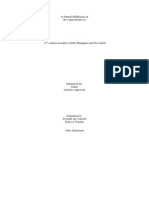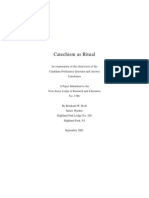Asynchronous Assessment
Uploaded by
Angelica AntonioAsynchronous Assessment
Uploaded by
Angelica AntonioRepublic of the Philippines
POLYTECHNIC UNIVERSITY OF THE PHILIPPINES
OFFICE OF THE VICE PRESIDENT FOR THE BRANCHES AND CAMPUSES
TAGUIG BRANCH
ASYNCHRONOUS ASSESSMENT
Angelica C. Antonio BSEDEN 2-1
NENENG ANABELLA
By Mena Pecson Crisologo By Magdalena Jaladoni
Plot and Structure Theme
- "Neneng" by Mena Pecson Crisologo is a love - Love and sacrifice is Magdalena Jalandoni's
story about Mauricio and Neneng, a young central topic in "Anabella". The story delves into
couple from a small rural community. But her the great emotional and moral complexity that
family is against their love and wants her to wed a emerge when persons must make difficult
richer suitor. Neneng is torn between duty and decisions between their own happiness and their
love, which causes emotional agony. is a love commitments to their families or society. It
story about Neneng, a young woman from a rural explores how love frequently necessitates making
hamlet who falls in love with Mauricio. The play compromises in oneself and the fortitude
climaxes with her important decision, which has required to face such difficulties. The book also
huge ramifications for her and those around her. discusses honor, duty, and the effect of society
But her family is against their love and wants her expectations* on personal life.
to wed a richer suitor. Neneng is torn between
duty and love, which causes emotional agony. Her
pivotal choice, which has far-reaching effects on
both her and those around her, sets up the story
conclusion.
The novel follows a traditional narrative
structure:
1. Exposition: Provide background information
about Neneng, her family, and the rural area.
2. Rising Action: The family's resistance and the
growth of Neneng's friendship with Mauricio.
3. Climax: Neneng must choose between duty
and love.
4. Falling Action: The results of her decision right
away.
5. Denouement: A conclusion and a consideration
of the concepts of responsibility and love.
Characters and Characterization Structure
- 1. Neneng: The protagonist, a lovely and moral 1. Exposition: Provides background information
young lady divided between her love for her on the story's social and cultural context by
family and her own desires. introducing the key characters and establishing
2. Mauricio: Neneng's true affection, devoted to the rural Philippine setting.
him.
Republic of the Philippines
POLYTECHNIC UNIVERSITY OF THE PHILIPPINES
OFFICE OF THE VICE PRESIDENT FOR THE BRANCHES AND CAMPUSES
TAGUIG BRANCH
3. Neneng's Family: Traditional and practical, they 2. Rising Action: This section focuses on Anabella
put their financial security and social standing and her inner difficulties as she balances duty and
ahead of Neneng's happiness. love, while also developing the connections and
4. Wealthier Suitor: Selected by Neneng's family, tensions among the characters.
this figure symbolizes both material wealth and
social standing. 3. Climax: The crucial point at which Anabella
must make a choice or encounter a dilemma that
puts her love, duty, or devotion to the test.
4. Falling Action: Addresses the fallout from the
climax, following characters' reactions to their
choices as the story starts to come to an end.
5. Resolution: The story's denouement, in which
unresolved issues are addressed and the
characters' ultimate destiny is disclosed.
All things considered, "Anabella" uses a
methodical approach to examine its themes of
love, sacrifice, and social expectations, providing
readers with a cogent and captivating narrative.
Themes and Motifs Imagery
Themes The rich and vivid imagery in "Anabella"
frequently draws inspiration from the Philippines'
1. Love vs. Duty: The struggle between one's own natural and cultural environments to strengthen
aspirations and those of one's family. the story:
2. Social Pressure: The impact of customs and
societal standards on personal decisions. 1. Rural Setting: The reader is drawn into the
3. Sacrifice: The giving up of one's own interests story's colorful rural Philippine setting by
for the benefit of one's family and society. descriptions of verdant vistas, rice fields, and
sleepy communities.
2. Cultural Symbols: The story is enhanced with
Motifs cultural authenticity with imagery pertaining to
Filipino customs and traditions, such as fiestas,
1. Marriage Arrangements: Stressing family ancestral homes, and regional cuisine.
control and society conventions. 3. Emotional States: Characters' emotional states
2. Inner Conflict: Symbolizing the characters' are portrayed by sensory and visual details; for
moral and emotional conflicts. example, the warmth of family get-togethers
3. Wealth and Status: Comparing financial contrasts with times of reflection and seclusion.
possessions and social status with genuine 4. Nature: Throughout the story, images of
affection. tropical plants and animals are used to represent
development, rebirth, and the passing of time.
Republic of the Philippines
POLYTECHNIC UNIVERSITY OF THE PHILIPPINES
OFFICE OF THE VICE PRESIDENT FOR THE BRANCHES AND CAMPUSES
TAGUIG BRANCH
In general, the imagery in "Anabella" reinforces
the story's themes of love, duty, and the
complexity of Filipino society while drawing the
reader further into the narrative.
Setting and Context Tone and Mood
Tone: Self-aware and reflective, expressing the
1.Rural hamlet: Traditional Filipino culture and characters' moral quandaries and internal
values provide the backdrop of this story, which is conflicts.
set in a rural hamlet in the Philippines. Mood: The emotional depth of love, sacrifice, and
2. Early 20th Century: The era captures the social societal expectations in a rural Philippine
and cultural aspects of this period in the early environment are captured in this intriguing and
1900s, with a focus on arranged marriages and tragic piece.
family honor.
Context
1. Cultural Traditions: The narrative emphasizes
the values and traditions of the Filipino people,
particularly with regard to marriage and family
fidelity.
2. Social Hierarchies: The story examines class
divides and the weight given to wealth and social
standing when making marriage-related
decisions.
3. Colonial Influence: The story is set in a period
of American colonial control, which has a subtle
impact on the social mores and conflicts that are
portrayed in it.
Language and Style Language and Diction
Ilocano: The novel is written in the Ilocano Language: The novel captures the spirit of
language, reflecting the local culture and Philippine culture and rural life with its clear and
traditions. expressive Filipino prose.
Diction: The author uses poetic and descriptive
Style language to capture the feelings of the characters
as well as the natural environment and subtle
- Descriptive and Emotive: The story beautifully cultural details of the locale. The language brings
captures the feelings of the characters as well as the reader closer to the action by capturing the
the rural environment. - *Traditional Narrative*: complexity and beauty of the characters'
Has a distinct plot with a linear progression of struggles and experiences.
characters and moral lessons.
Republic of the Philippines
POLYTECHNIC UNIVERSITY OF THE PHILIPPINES
OFFICE OF THE VICE PRESIDENT FOR THE BRANCHES AND CAMPUSES
TAGUIG BRANCH
You might also like
- 2analysis of How My Brother Leon Brought Home A Wife100% (2)2analysis of How My Brother Leon Brought Home A Wife6 pages
- Terminal Requirements in EL 111: Survey of Philippine LiteratureNo ratings yetTerminal Requirements in EL 111: Survey of Philippine Literature6 pages
- Footnote To Youth by Jose Garcia Villa Analysis60% (5)Footnote To Youth by Jose Garcia Villa Analysis1 page
- DEAD STARS - TOLENTINO, LOUISE ALESSANDRA A.No ratings yetDEAD STARS - TOLENTINO, LOUISE ALESSANDRA A.8 pages
- "How My Brother Leon Brought Home A Wife": A Critical Analysis OnNo ratings yet"How My Brother Leon Brought Home A Wife": A Critical Analysis On5 pages
- Assessment On Short Stories - Taglucop - Eng3BNo ratings yetAssessment On Short Stories - Taglucop - Eng3B5 pages
- Reflection of The Story "How My Brother Leon Brought Home A Wife"0% (1)Reflection of The Story "How My Brother Leon Brought Home A Wife"5 pages
- St. Paul University Philippines: Love in The Cornhusks Aida Rivera-FordNo ratings yetSt. Paul University Philippines: Love in The Cornhusks Aida Rivera-Ford3 pages
- In Partial Fulfillment of The Requirement of 21 Century LiteratureNo ratings yetIn Partial Fulfillment of The Requirement of 21 Century Literature14 pages
- 21st Century Literature From The Philippines and The World100% (2)21st Century Literature From The Philippines and The World3 pages
- How My Brother Leon Brought Home A WifeNo ratings yetHow My Brother Leon Brought Home A Wife28 pages
- Survey of Philippine Literature in EnglishNo ratings yetSurvey of Philippine Literature in English26 pages
- "How My Brother Leon Brought Home A Wife": Philippine Literature100% (1)"How My Brother Leon Brought Home A Wife": Philippine Literature4 pages
- 21 Century Literature: Unit II Philippine Literature From The RegionNo ratings yet21 Century Literature: Unit II Philippine Literature From The Region23 pages
- Philippine National Artists in Literature and Their Literary WorksNo ratings yetPhilippine National Artists in Literature and Their Literary Works35 pages
- Chapter 3 Literature under Spanish ColonialismNo ratings yetChapter 3 Literature under Spanish Colonialism15 pages
- How My Brother Leon Brought Home A Wife_ Christine Camalao printNo ratings yetHow My Brother Leon Brought Home A Wife_ Christine Camalao print6 pages
- The Art of Story-Telling: With nearly half a hundred storiesFrom EverandThe Art of Story-Telling: With nearly half a hundred storiesNo ratings yet
- The Effectiveness of Sustainability Practices To Business Performance of Selected Hotels in Taguig CityNo ratings yetThe Effectiveness of Sustainability Practices To Business Performance of Selected Hotels in Taguig City38 pages
- Literary Analysis in Philippine Literature 2No ratings yetLiterary Analysis in Philippine Literature 28 pages
- Dialectical Behavior Therapy and Suicidal Behavior in Adolescence: Linking Developmental Theory and PracticeNo ratings yetDialectical Behavior Therapy and Suicidal Behavior in Adolescence: Linking Developmental Theory and Practice10 pages
- The Neuroscience of Psychotherapy 3rd Edition Louis Cozolino download pdf100% (4)The Neuroscience of Psychotherapy 3rd Edition Louis Cozolino download pdf65 pages
- Stocco, Melisa - Approaching Self-Translation in Latin American Indigenous Literatures. The Mapuche Bilingual Poetry of Elicura ChihuNo ratings yetStocco, Melisa - Approaching Self-Translation in Latin American Indigenous Literatures. The Mapuche Bilingual Poetry of Elicura Chihu16 pages
- The clinical Erich Fromm personal accounts and papers on therapeutic technique Fromm - The latest ebook is available, download it today100% (1)The clinical Erich Fromm personal accounts and papers on therapeutic technique Fromm - The latest ebook is available, download it today60 pages
- Diagnostic Test in English 10: Matag-Ob National High SchoolNo ratings yetDiagnostic Test in English 10: Matag-Ob National High School4 pages
- Lesson 14:: "The Software As An Educational Resource" ExperienceNo ratings yetLesson 14:: "The Software As An Educational Resource" Experience6 pages





























































































